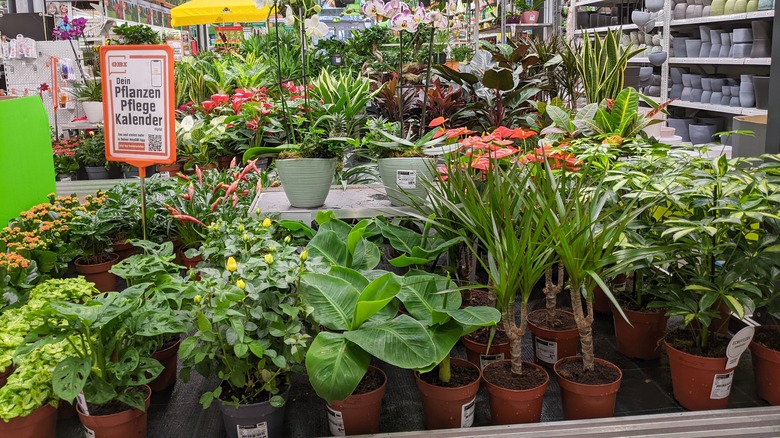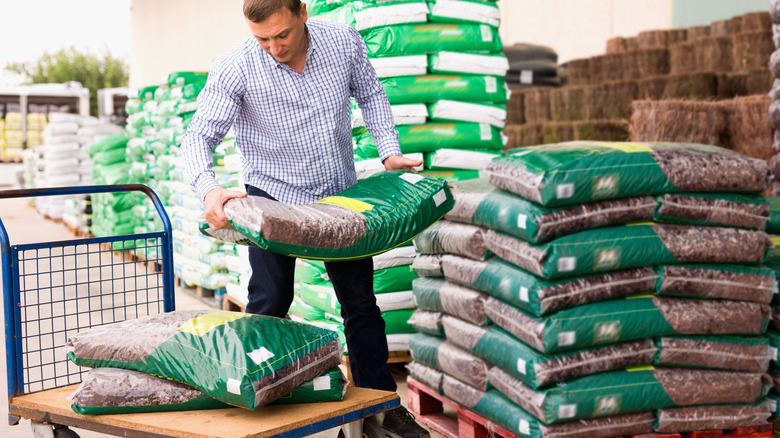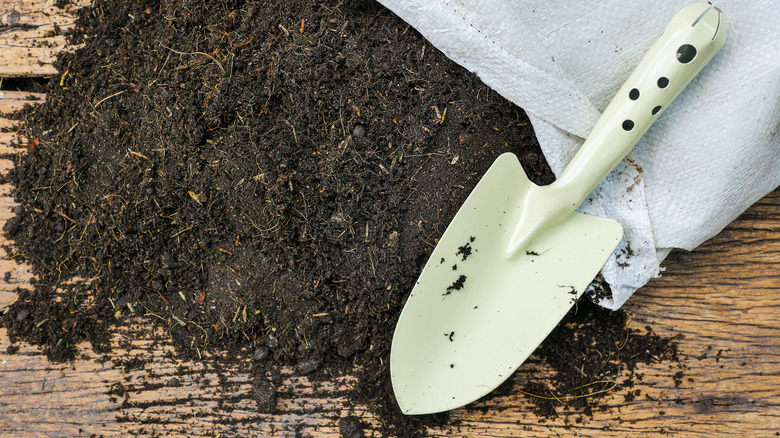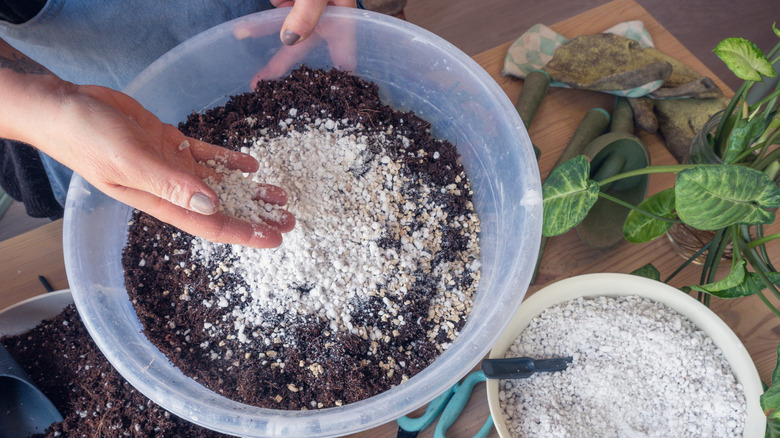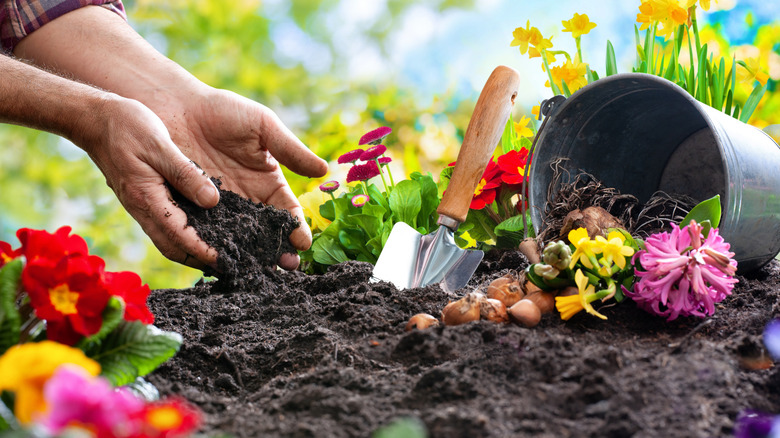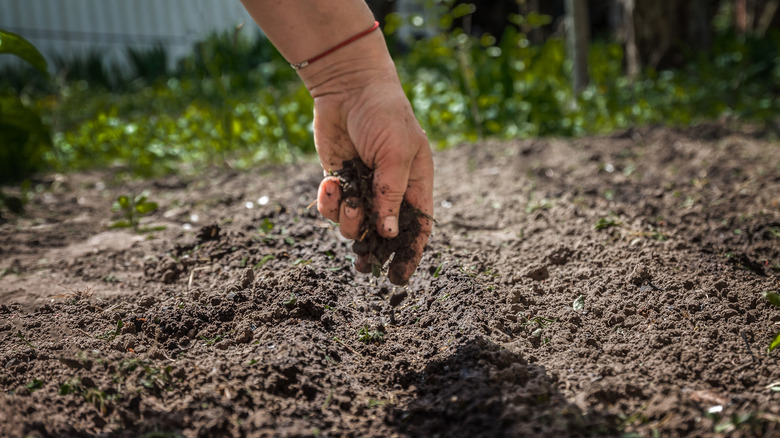What You Need To Know Before Buying Soil At Home Depot
Home Depot is one of the most popular home improvement stores, earning over $151 billion in annual sales in 2021, offering a variety of products for DIYers and professionals alike (via Statista). Whether you're building a house, renovating your bathroom, plastering holes in your walls, or updating your garden, you're sure to find products that fit your needs at the store.
One of the products found in plentiful amounts at Home Depot is soil. Whether potting, garden, raised bed, succulent, or topsoil — there is no shortage of soil to fit your needs at the home improvement store's garden section. With such variety, though, there are a few things you should know before just grabbing a bag at random. Things like your soil's natural texture, pH level, your plants' needs, how you're growing them, and more all impact what soil you need. If you're working on a larger project, like a total landscape redesign, you should also know about potential bulk deals offered through Home Depot's special orders.
1. Save money with special orders
If you're working on a larger-scale project, like totally redoing your yard, planting lots of trees, etc., you'll need a lot of soil. Smaller projects may only need two to three bags, like covering lawn seed, but larger projects like filling a large raised bed could require as much as 32 bags of soil, per Swansons Nursery.
If you find yourself in the latter group needing lots of soil, the high price tag may make you nervous. Similarly, the idea of transporting that much dirt may sound overwhelming. Luckily, Home Depot offers special quotes and custom orders for those needing large quantities of items like soil. According to Home Depot's special order site, this option lets you buy up to three times as much product as you could in the store. It also offers bulk pricing deals and delivery to your job site or home. The cost will vary based on the size of your project, but all you need to do is find a Home Depot and go to the Pro Desk, give them the details and size of your project, and they'll offer you a quote and timeline in accordance with your needs.
2. Why different plants need different soil
While there may not seem to be much difference between soil types, different plants, climates, and natural soil textures have vastly different requirements. When heading to Home Depot for your next bag, whether it's to repot a houseplant or fill up a large garden bed, you should know what product to choose.
A trip to the soil aisle will quickly reveal lots of different, confusing options, though. Home Depot notes that different regions have different soil conditions, including varying pH levels and textures. Generally, plants prefer to grow at pH levels between 6 and 7. The Pacific Northwest, as well as the Eastern and Southeastern parts of the United States, tend to have very acidic soils, though, with Western parts of the country having more alkaline soils naturally (per Earth Science). Similarly, some regions have very clay-rich soils, with others having very sandy and dry soil conditions. Different container sizes also require you to get different soils, as you need to be able to feed the plant's roots properly.
3. Use potting mix for indoor and container plants
Potting soil is one of the more popular and well-known soil options, most often found in the indoor section of any garden center, Home Depot included. This is because any potted plant, particularly houseplants, will need more concentrated nutrients directed to their roots. As Proven Winners notes, potting mix is specially formulated to help the roots retain moisture and be light enough that the plant can breathe. If the mixture is too thick, it could choke the plant, and if it's too light, the soil could get thin and leave the roots without support.
As noted earlier, there are lots of factors at play when it comes to outdoor soil. It could be too dense or light, acidic or alkaline, sandy or clay-rich, etc. Potting soil is also sterilized, which helps prevent fungus from growing. Hardier outdoor plants may be able to handle that, but potted or container plants are smaller and not as established and need specially sterilized conditions.
4. Garden soil helps improve your dirt
Garden soil may sound self-explanatory, even unnecessary, but it's essential for various reasons. According to The Budding Planter, garden soil isn't simply dirt from the ground but a mix of compost, nutrients, minerals, other organic matter, and dirt, formulated to target any lack of nutrients your native soil may have. You can usually find this in larger bags outdoors at Home Depot. It is also heavier and meant to hold onto water better than other soils. For this reason, it's meant to be used in the ground, as it could quickly suffocate or drown container plants.
Generally, you incorporate garden soil by digging a hole appropriately sized for your plant — a shrub, tree, etc. Then, dig out a little extra, incorporating the garden soil into the missing space. As you put your plant in the ground, you'll mix in more garden soil with a bit of the natural dirt.
5. Topsoil can level your yard
Topsoil is another popular type of bagged soil sold at garden centers and stores like Home Depot and is usually the cheapest of the available options. Topsoil doesn't function like garden or potting soil, though, because it isn't meant to provide specific nutrients or conditions to a plant. That being said, it is full of nutrients and minerals typically found within the first 6 inches of ground soil, per Haynes.
Topsoil is typically used for large-scale gardening and landscaping projects, like leveling out a yard, filling patches and holes in the earth, etc. Topsoil is a great way to soak up large areas of sitting water or puddles in your yard. If your plants look a little lifeless, tilling up your old dirt and adding some topsoil is a great way to bring them back to life. Topsoil is also an attractive, earthy brown color and can help aesthetically liven up your garden.
